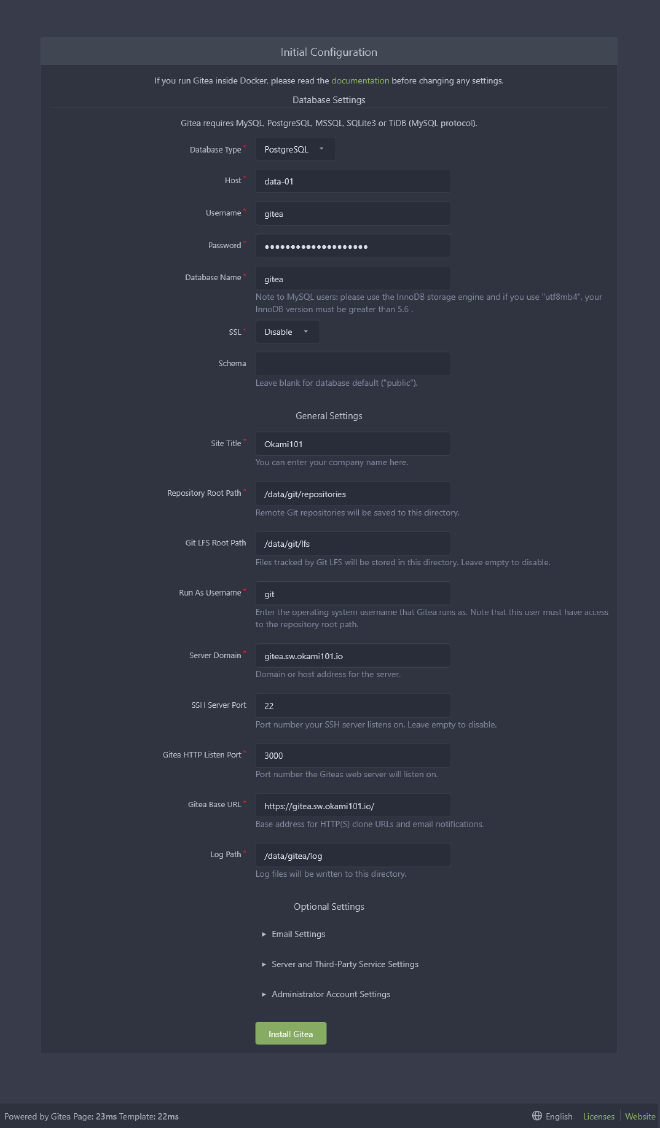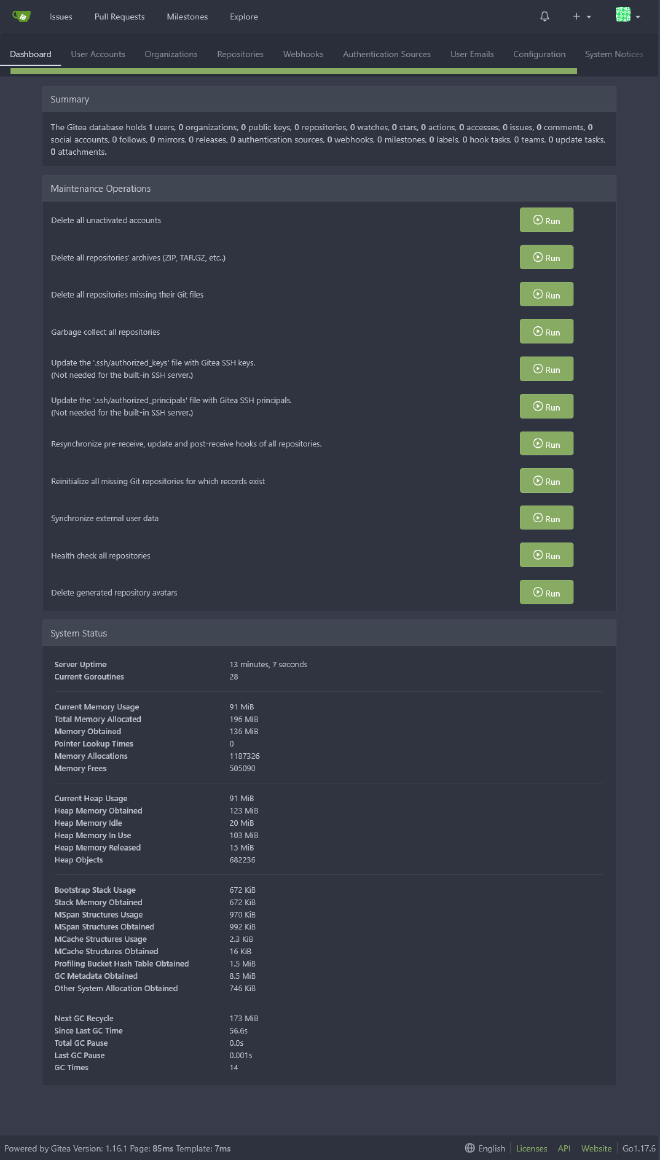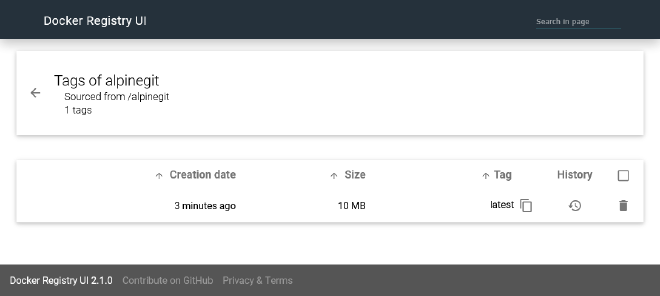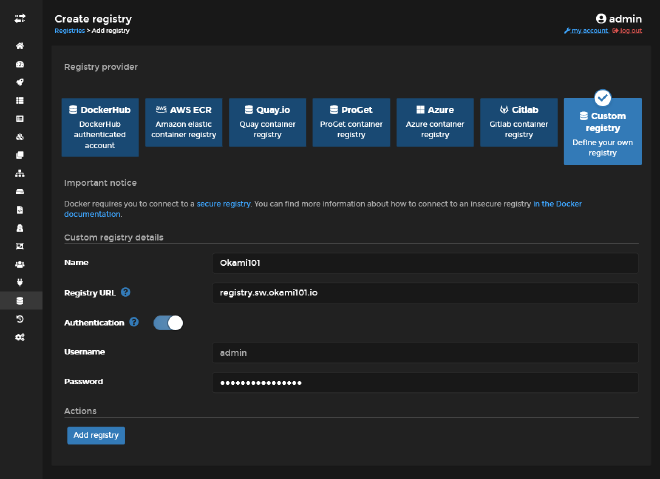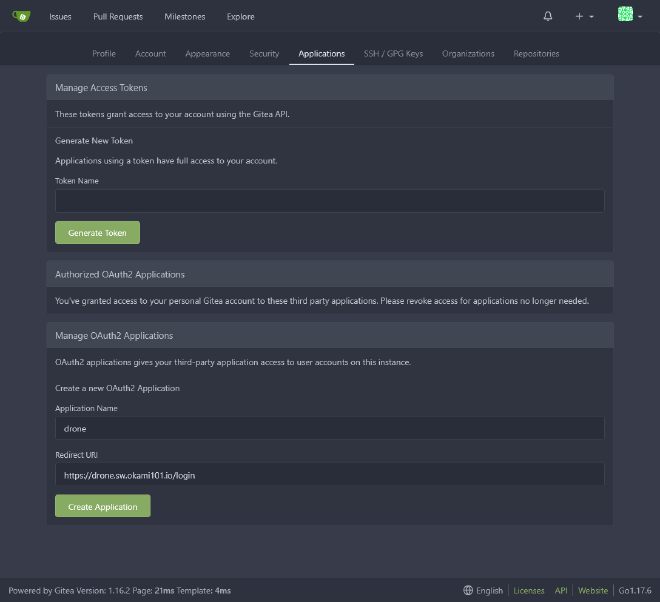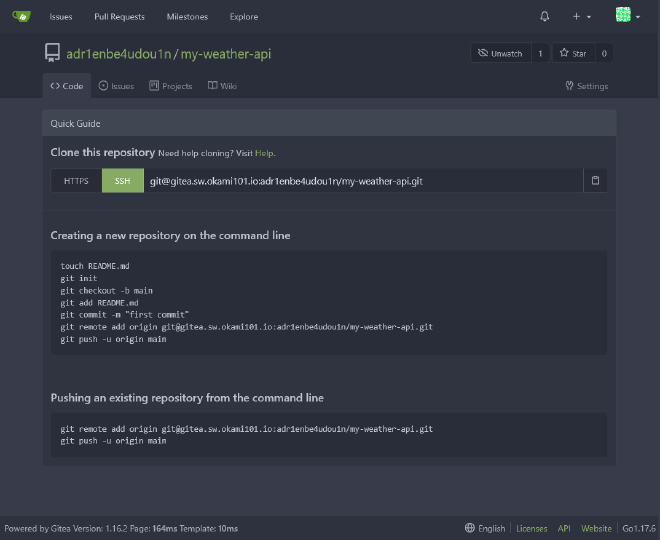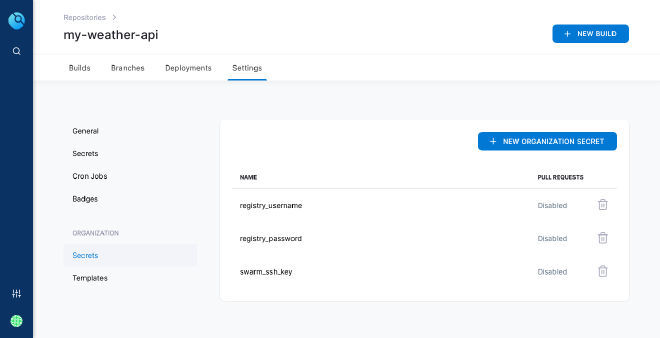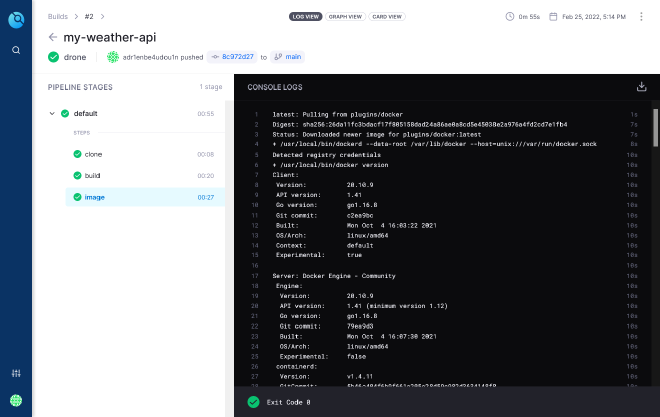Setup a Docker Swarm cluster Part VII - CI/CD workflow
Table of Contents
This is the Part VII of more global topic tutorial. Back to first part for intro.
Self-hosted VCS 🍵 #
This specific VCS part is optional and is only for developers that would be completely independent of any cloud VCS providers, by self-hosting its own system.
Of course, in this low-budget cluster, forget about running properly a self-hosted GitLab, you will be forced to have an additionnal worker node with at least 4Gb fully dedicated just for running it. I will privilege here a super lightweight solution, Gitea. Besides, the last version 1.16 finally support dark mode !
Install Gitea 💽 #
You guess it, it’s just an additional stack to run !
Do sudo mkdir /mnt/storage-pool/gitea and create next stack :
version: '3.8'
services:
gitea:
image: gitea/gitea:1.16
volumes:
- /etc/hosts:/etc/hosts
- /mnt/storage-pool/gitea:/data
networks:
- traefik_public
deploy:
labels:
- traefik.enable=true
- traefik.http.routers.gitea.entrypoints=https
- traefik.http.services.gitea.loadbalancer.server.port=3000
- traefik.tcp.routers.gitea-ssh.rule=HostSNI(`*`)
- traefik.tcp.routers.gitea-ssh.entrypoints=ssh
- traefik.tcp.services.gitea-ssh.loadbalancer.server.port=22
placement:
constraints:
- node.role == manager
networks:
traefik_public:
external: true
Now go to https://gitea.sw.dockerswarm.rocks and go through the installation procedure. Change default SQLite provider by a more production purpose database.
Create a new gitea PostgreSQL database as usual from pgAdmin or psql for pro-CLI user, and set the according DB info access to Gitea installer. Host should be data-01.
Don’t forgive to change all domain related field by the proper current domain URL. You should set proper SMTP settings for notifications.
For information all these settings will be saved in /mnt/storage-pool/gitea/gitea/conf/app.ini file. You can change them at any time. You may want to disable registration by changing DISABLE_REGISTRATION.
Next just create your first account. The 1st account will be automatically granted to administrator.
You should now test creating some repos and be sure that git cloning works on both HTTPS and SSH protocol. For SSH be sure to add your own SSH public key in your profile.
Private docker registry #
Before attack the CI/CD part, we should take care of where we put our main docker images that will be automatically be built when every code pushes. You have the choice to use main Docker hub of course but honestly, we have a full cluster now, let’s use it fully !
Install official docker registry 💽 #
We’ll use the official docker registry with addition of nice simple UI for images navigation. It’s always the same, do sudo mkdir /mnt/storage-pool/registry and create next stack :
version: '3.8'
services:
app:
image: registry:2
environment:
REGISTRY_STORAGE_DELETE_ENABLED: 'true'
volumes:
- /mnt/storage-pool/registry:/var/lib/registry
networks:
traefik_public:
deploy:
labels:
- traefik.enable=true
- traefik.http.routers.registry.entrypoints=https
- traefik.http.routers.registry.middlewares=admin-auth
- traefik.http.routers.registry.rule=Host(`registry.sw.dockerswarm.rocks`) && PathPrefix(`/v2`)
- traefik.http.services.registry.loadbalancer.server.port=5000
placement:
constraints:
- node.role == manager
ui:
image: joxit/docker-registry-ui
environment:
DELETE_IMAGES: 'true'
SINGLE_REGISTRY: 'true'
networks:
traefik_public:
deploy:
labels:
- traefik.enable=true
- traefik.http.routers.registryui.entrypoints=https
- traefik.http.routers.registryui.middlewares=admin-auth
- traefik.http.services.registryui.loadbalancer.server.port=80
placement:
constraints:
- node.role == manager
networks:
traefik_public:
external: true
PathPrefix feature provided by Traefik with /v2.It gives us have an additional condition for redirect to the correct service. It’s ok in our case because the official docker registry use only
/v2 as endpoint.Go to https://registry.sw.dockerswarm.rocks and use Traefik credentials. We have no images yet let’s create one.
Test our private registry #
Create a Dockerfile sample file somewhere :
FROM alpine:latest
RUN apk add --no-cache git
Then build and push the image :
# enter proper credentials
docker login registry.sw.dockerswarm.rocks
# build the image
docker build -t alpinegit .
docker tag alpinegit registry.sw.dockerswarm.rocks/alpinegit
docker push registry.sw.dockerswarm.rocks/alpinegit
Go back to above https://registry.sw.dockerswarm.rocks. You should see 1 new image !
Delete the image test through UI and from local docker with docker image rm registry.sw.dockerswarm.rocks/alpinegit.
For that execute
registry garbage-collect /etc/docker/registry/config.yml inside docker registry container console. You can ssh into it directly through Portainer.Register registry in Portainer #
For our future app deployments from our built docker image, we need to register our new private registry with proper credentials. Go to Registries menu of Portainer, and create the new registry.
Save it, and you have registered repository, which will allow proper pulling from it for next custom app stack deployments.
CI/CD with Drone 🪁 #
It’s finally time to use our currently unused runner-01 ! We’ll use Drone as free self-hosted solution for docker image building. The all CI/CD process can be summarized to this flow chart :
Let’s follow the official docs for generating a OAuth2 application on Gitea, which is necessary for Drone integration. Set https://drone.sw.dockerswarm.rocks as redirect UI after successful authentication.
Save and keep the client and secret tokens. Then create a new drone PostgreSQL database and create next stack :
version: '3.8'
services:
drone:
image: drone/drone:2
volumes:
- /etc/hosts:/etc/hosts
environment:
DRONE_DATABASE_DRIVER: postgres
DRONE_DATABASE_DATASOURCE: postgres://drone:${DRONE_DATABASE_PASSWORD}@data-01:5432/drone?sslmode=disable
DRONE_GITEA_CLIENT_ID:
DRONE_GITEA_CLIENT_SECRET:
DRONE_GITEA_SERVER: https://gitea.sw.dockerswarm.rocks
DRONE_RPC_SECRET:
DRONE_SERVER_HOST:
DRONE_SERVER_PROTO:
DRONE_USER_CREATE: username:adr1enbe4udou1n,admin:true
networks:
- traefik_public
deploy:
labels:
- traefik.enable=true
- traefik.http.routers.drone.entrypoints=https
- traefik.http.services.drone.loadbalancer.server.port=80
placement:
constraints:
- node.role == manager
runner-docker:
image: drone/drone-runner-docker
volumes:
- /var/run/docker.sock:/var/run/docker.sock
environment:
DRONE_RPC_SECRET:
DRONE_RPC_HOST: ${DRONE_SERVER_HOST}
DRONE_RPC_PROTO: ${DRONE_SERVER_PROTO}
deploy:
placement:
constraints:
- node.labels.environment == build
networks:
traefik_public:
external: true
node.labels.environment == build.| variable | description |
|---|---|
DRONE_SERVER_HOST | The host of main Drone server. I’ll use drone.sw.dockerswarm.rocks here. |
DRONE_SERVER_PROTO | The scheme protocol, which is https. |
DRONE_GITEA_CLIENT_ID | Use the above client ID token. |
DRONE_GITEA_CLIENT_SECRET | Use the above client secret token. |
DRONE_DATABASE_PASSWORD | Use the database password. |
DRONE_RPC_SECRET | Necessary for proper secured authentication between Drone and runners. Use openssl rand -hex 16 for generating a valid token. |
DRONE_USER_CREATE | The initial user to create at launch. Put your Gitea username here for setting automatically Gitea user as drone administrator. |
It’s time to go to https://drone.sw.dockerswarm.rocks and generate your first Drone account through OAuth2 from Gitea. You should be properly redirected to Gitea, where you’ll just have to authorize Drone application.
Finalize registration, and you should finally arrive to main Drone dashboard. If you have already created some repositories, they should appear in the list.
successfully pinged the remote server.Test with basic project #
We have all the minimal CI/CD pipeline in place ! Let’s create a basic backend Dotnet API and test all CI/CD workflow !
Create new API project ✨ #
Firstly, create a new my-weather-api private repository through Gitea. I’ll use main as default branch here.
Next I presume you have .NET SDK locally installed. Create a new ASP.NET Core Web API project and push into Gitea.
dotnet new webapi -o my-weather-api --no-https
cd my-weather-api
dotnet new gitignore
git init
git add .
git commit -m "first commit"
git remote add origin git@gitea.sw.dockerswarm.rocks:adr1enbe4udou1n/my-weather-api.git # if you use ssh
git push -u origin main
--no-https as we’ll use Traefik as main SSL provider, otherwise the app will not properly respond when deployed. It will simply skip the app.UseHttpsRedirection(); line code middleware.Project should be pushed correctly :
Drone configuration 🛠️ #
Let’s now activate the repo in Drone. Click on SYNC button. Click on new repo and activate the repository.
It will create a webhook inside repository settings, triggered on every code push.
Now generate a new SSH key on manager-01 :
ssh-keygen -t ed25519 -C "admin@sw.dockerswarm.rocks"
cat .ssh/id_ed25519 # the private key to set in swarm_ssh_key
cat .ssh/id_ed25519.pub # the public key to add just below
echo "ssh-ed25519 AAAA... admin@sw.dockerswarm.rocks" | tee -a .ssh/authorized_keys
Then configure the repository settings on Drone. Go to Organization > Secrets section and add some global secrets.
| name | description |
|---|---|
registry_username | The username access of our docker registry |
registry_password | The password access of our docker registry |
swarm_ssh_key | The private above key |
Configure the pipelines (the CI part) 🏗️ #
For working, Drone needs a .drone.yml file in root of repository. This file will describe all steps of our build pipeline. Let’s create and explain it :
kind: pipeline
type: docker
name: default
steps:
- name: build
image: mcr.microsoft.com/dotnet/sdk:6.0
commands:
- dotnet publish -c Release -o ./publish
- name: image
image: plugins/docker
settings:
registry: registry.sw.dockerswarm.rocks
repo: registry.sw.dockerswarm.rocks/adr1enbe4udou1n/my-weather-api
tags: latest
username:
from_secret: registry_username
password:
from_secret: registry_password
trigger:
event:
- push
- pull_request
It’s just simple 2 steps :
build: Here is the step for project dependencies import, compilation, testing, and code linting / formatting. This is a very basic project here, so we start with a simple building. The imagemcr.microsoft.com/dotnet/sdk:6.0is the required docker image for proper .NET building. The publish command will generate apublishsubdirectory.image: We use the official docker plugin for building our final production based docker image, done from the below Dockerfile. Userepoas the final docker image name.
Next create the Dockerfile which will be used for image step :
FROM mcr.microsoft.com/dotnet/aspnet:6.0
RUN apt-get install -y tzdata
COPY /publish /app
WORKDIR /app
ENTRYPOINT ["dotnet", "my-weather-api.dll"]
We use production suited .NET runtime image mcr.microsoft.com/dotnet/aspnet:6.0. Note as WE MUST do the simplest commands possible in order to have the lightest image layers, as it’s the production image. All we have to do is to copy the final published binaries from above build drone step.
Commit both above files and push to remote repo. Drone should be automatically triggered for building and activate the runner. The runner will clone the project and process all pipeline’s steps.
If all’s going well, the final image should be pushed in our docker registry. You can ensure it by navigating to https://registry.sw.dockerswarm.rocks.
Deployment (the CD part) 🚀 #
Our application is now ready for production deployment ! Let’s create our new shiny stack :
version: '3.8'
services:
app:
image: registry.sw.dockerswarm.rocks/adr1enbe4udou1n/my-weather-api
environment:
ASPNETCORE_ENVIRONMENT: Development
networks:
- traefik_public
deploy:
labels:
- traefik.enable=true
- traefik.http.routers.my-weather-api.entrypoints=https
- traefik.http.services.my-weather-api.loadbalancer.server.port=80
placement:
constraints:
- node.labels.environment == production
networks:
traefik_public:
external: true
Development in order to have the swagger UI.Be sure to have registered the private registry in Portainer before deploying as explained here.
Finally, deploy and see the result in https://weather.sw.dockerswarm.rocks/swagger. You should access to the swagger UI, and API endpoints should correctly respond.
Continuous deployment #
Now it’s clear that we don’t want to deploy manually every time when the code is pushed.
First be sure that following docker service update --image registry.sw.dockerswarm.rocks/adr1enbe4udou1n/my-weather-api:latest weather_app --with-registry-auth command works well in manager-01. It’s simply update the current weather_app service with the last available image version from the private registry.
Now we must be sure that the runner-01 host can reach the manager-01 server from outside. If you have applied the firewall at the beginning of this tutorial, only our own IP is authorized. Let’s add the public IP of runner-01 to your firewall-external inside Hetzner console.
Now let’s add a new deploy step inside .drone.yml into our pipeline for automatic deployment !
#...
- name: deploy
image: appleboy/drone-ssh
settings:
host: sw.dockerswarm.rocks
port: 2222
username: swarm
key:
from_secret: swarm_ssh_key
script:
- docker service update --image registry.sw.dockerswarm.rocks/adr1enbe4udou1n/my-weather-api:latest weather_app --with-registry-auth
#...
Let’s test by editing Program.cs file :
builder.Services.AddSwaggerGen(c =>
{
c.SwaggerDoc("v1", new OpenApiInfo
{
Title = "Weather API",
Version = "0.0.1",
});
});
Push and back to your API, and the title and version should be automatically updated !
6th check ✅ #
We’ve done all the main CI/CD part.
Now let’s go even further in the exploitation of our new cluster development environment in the last part.
